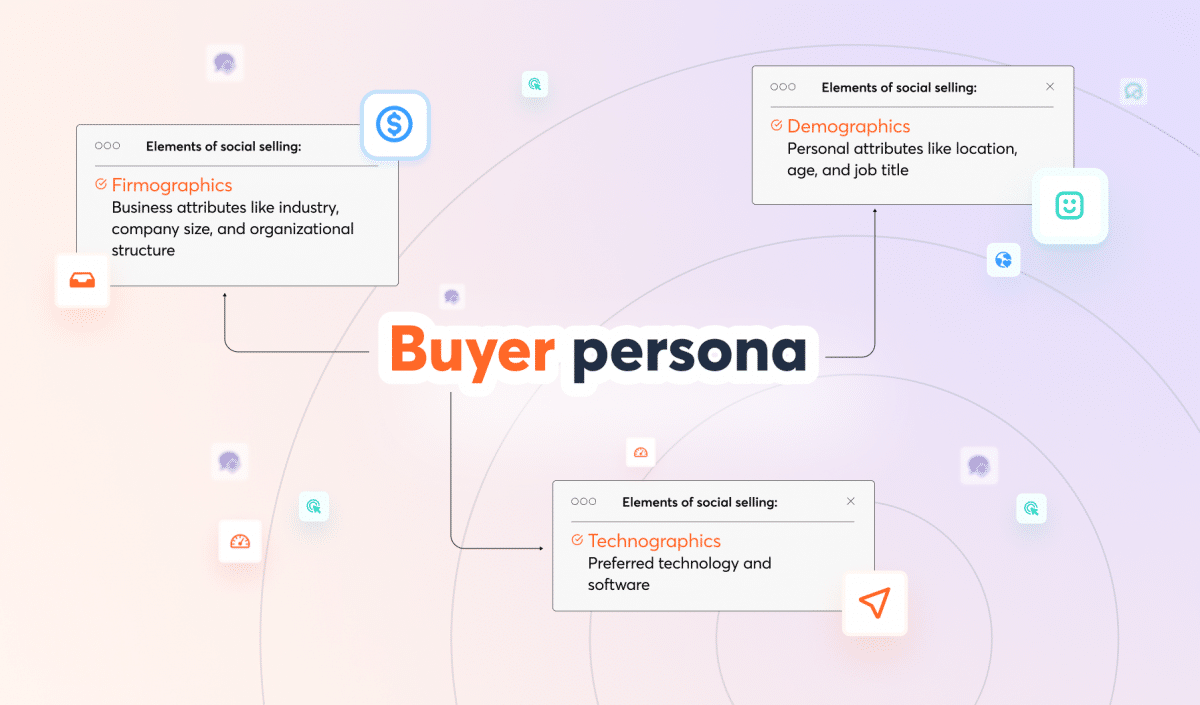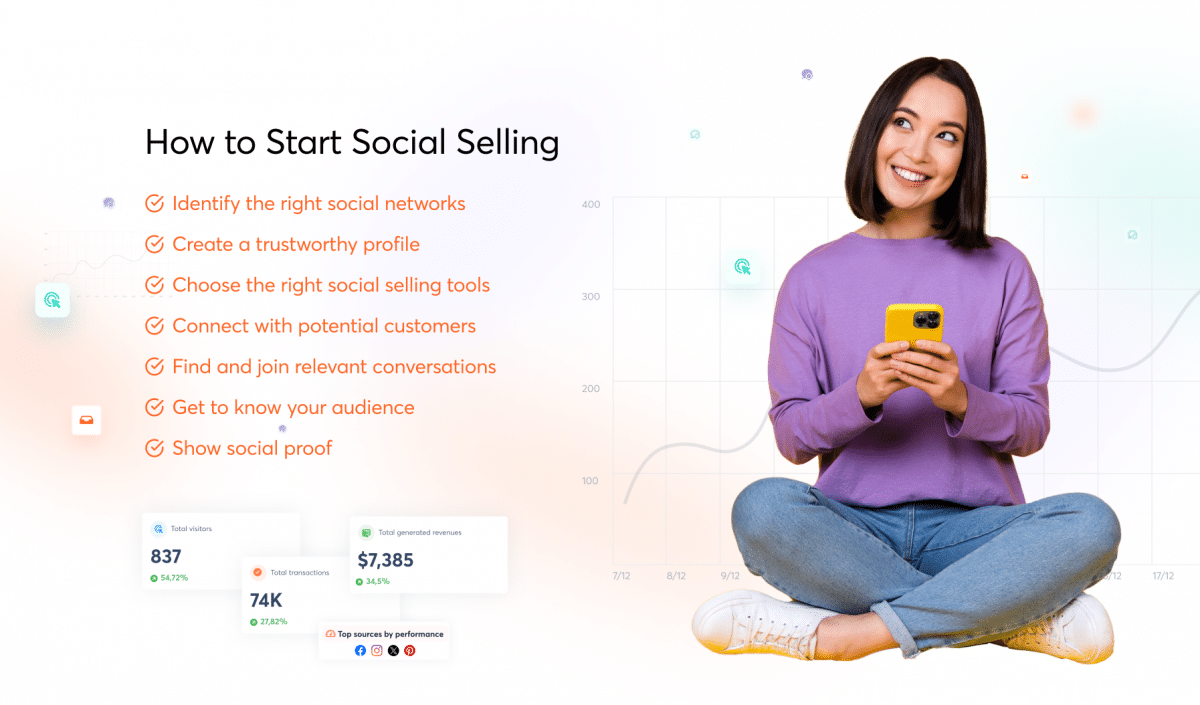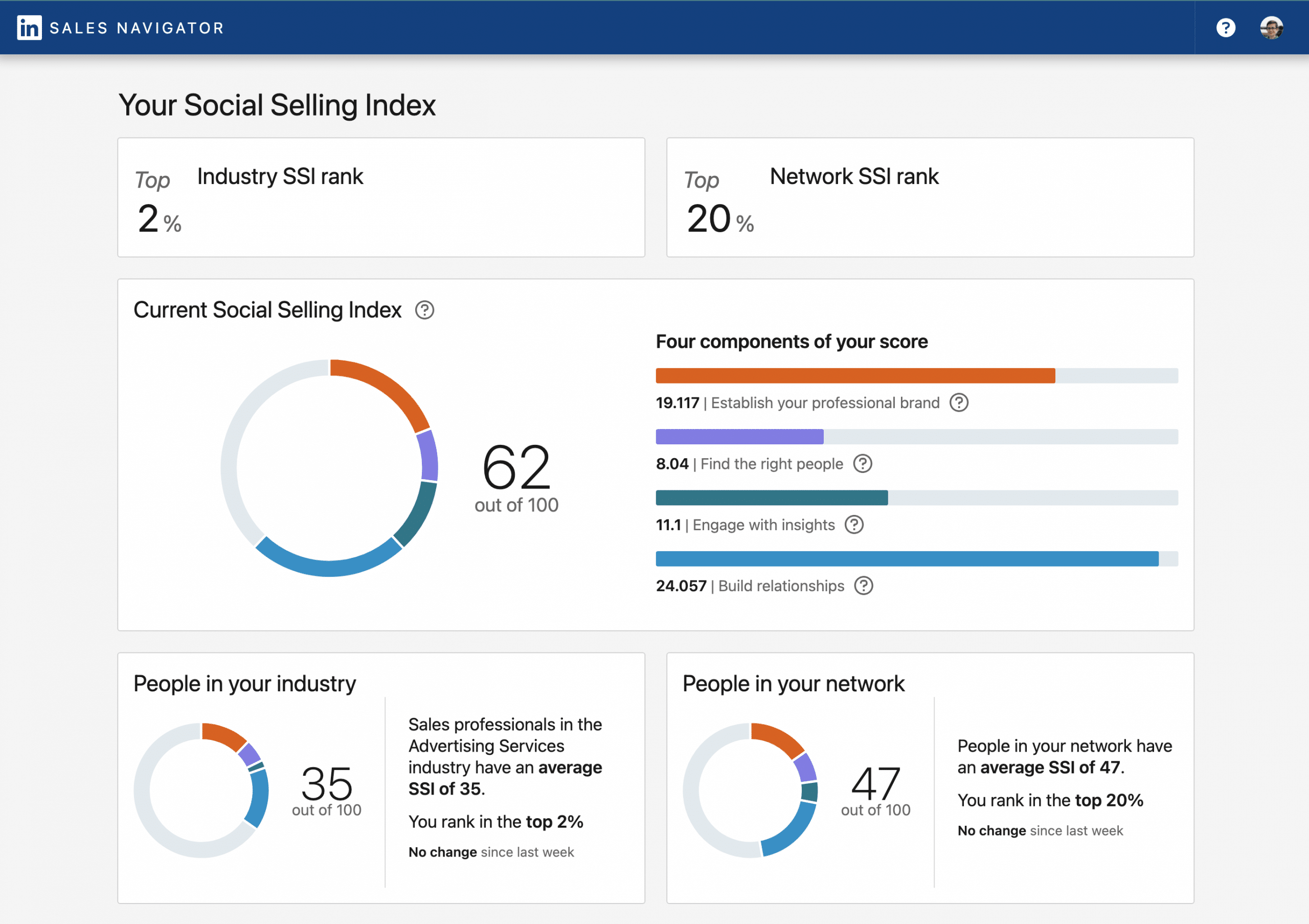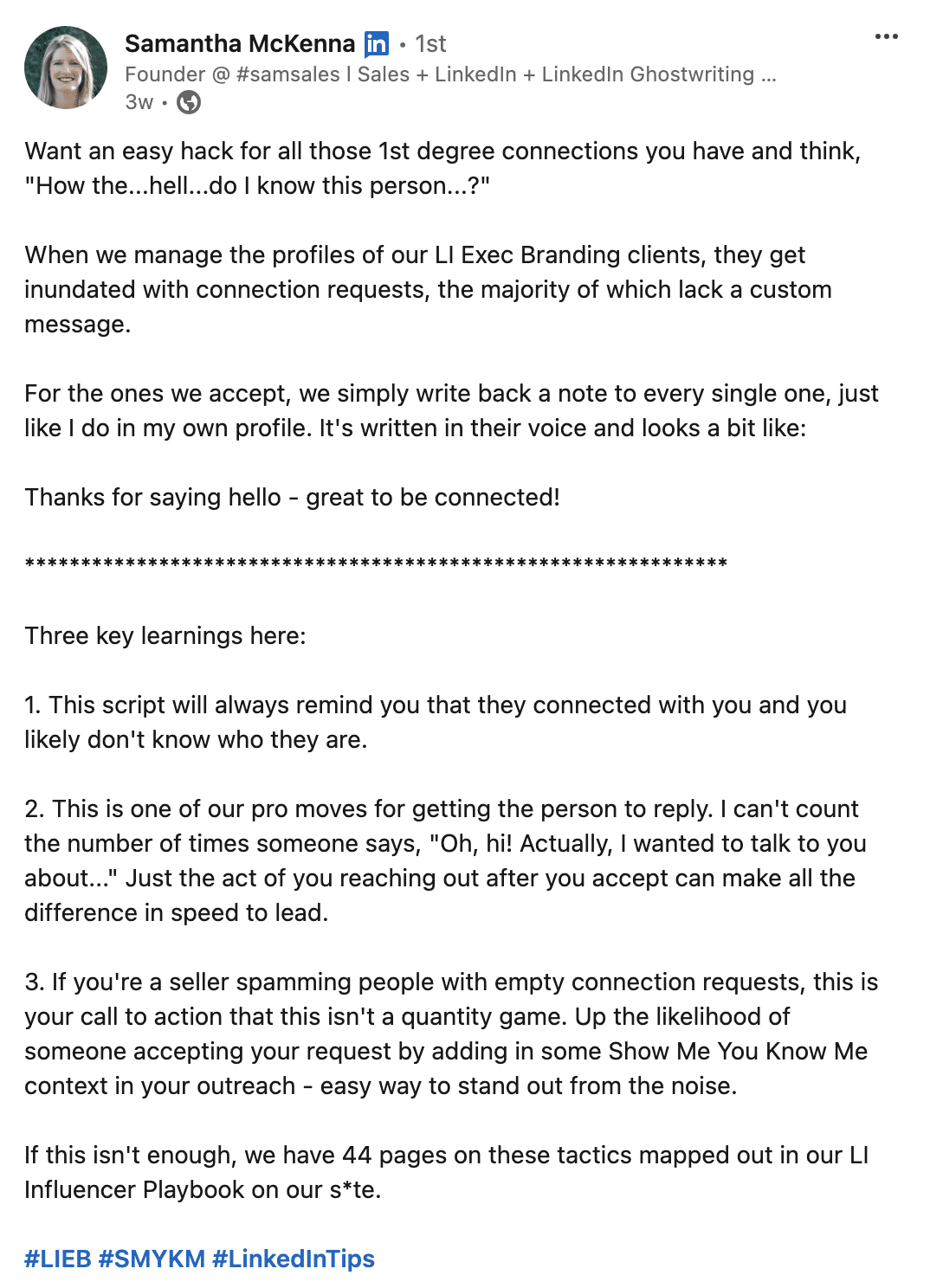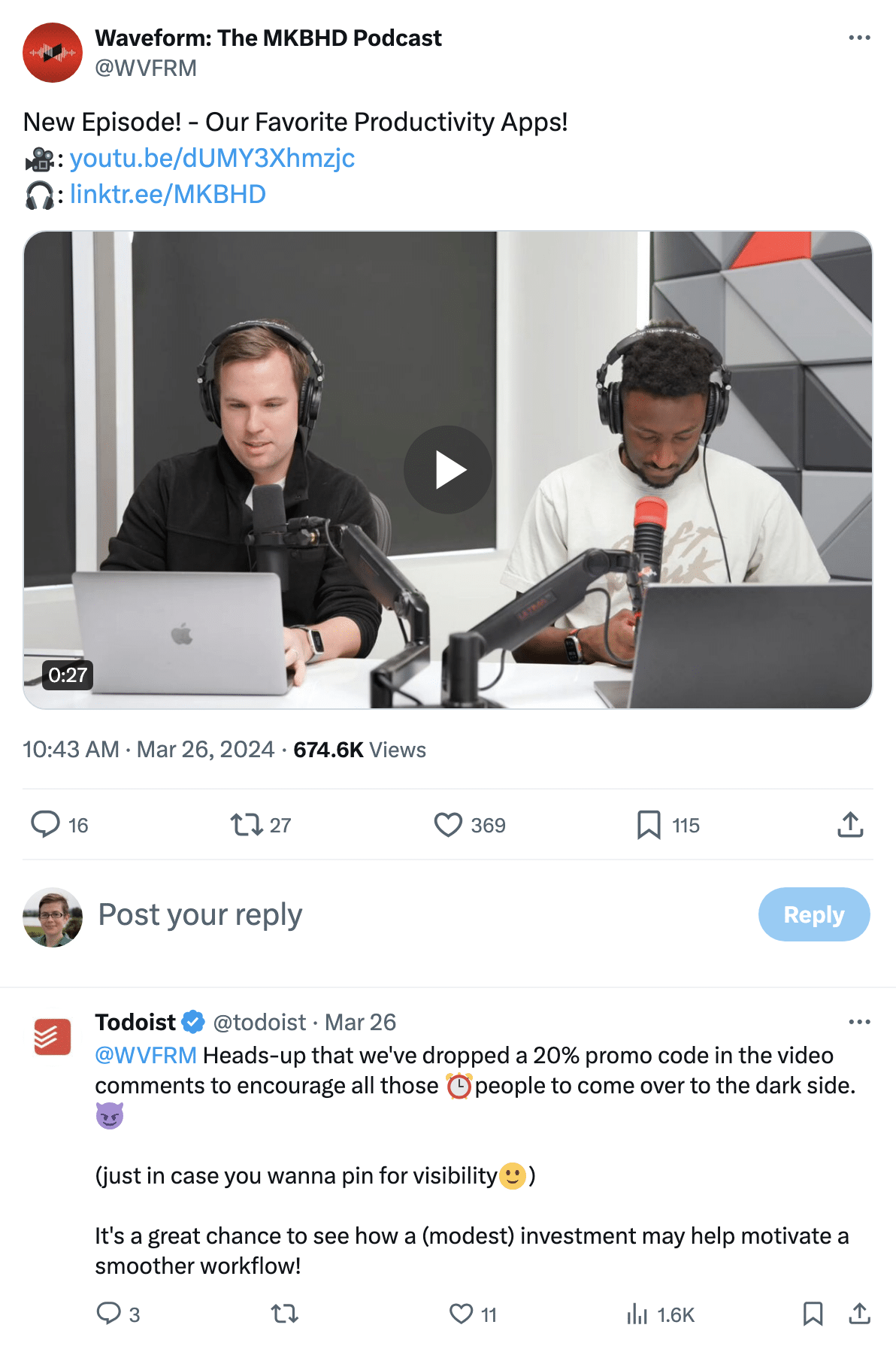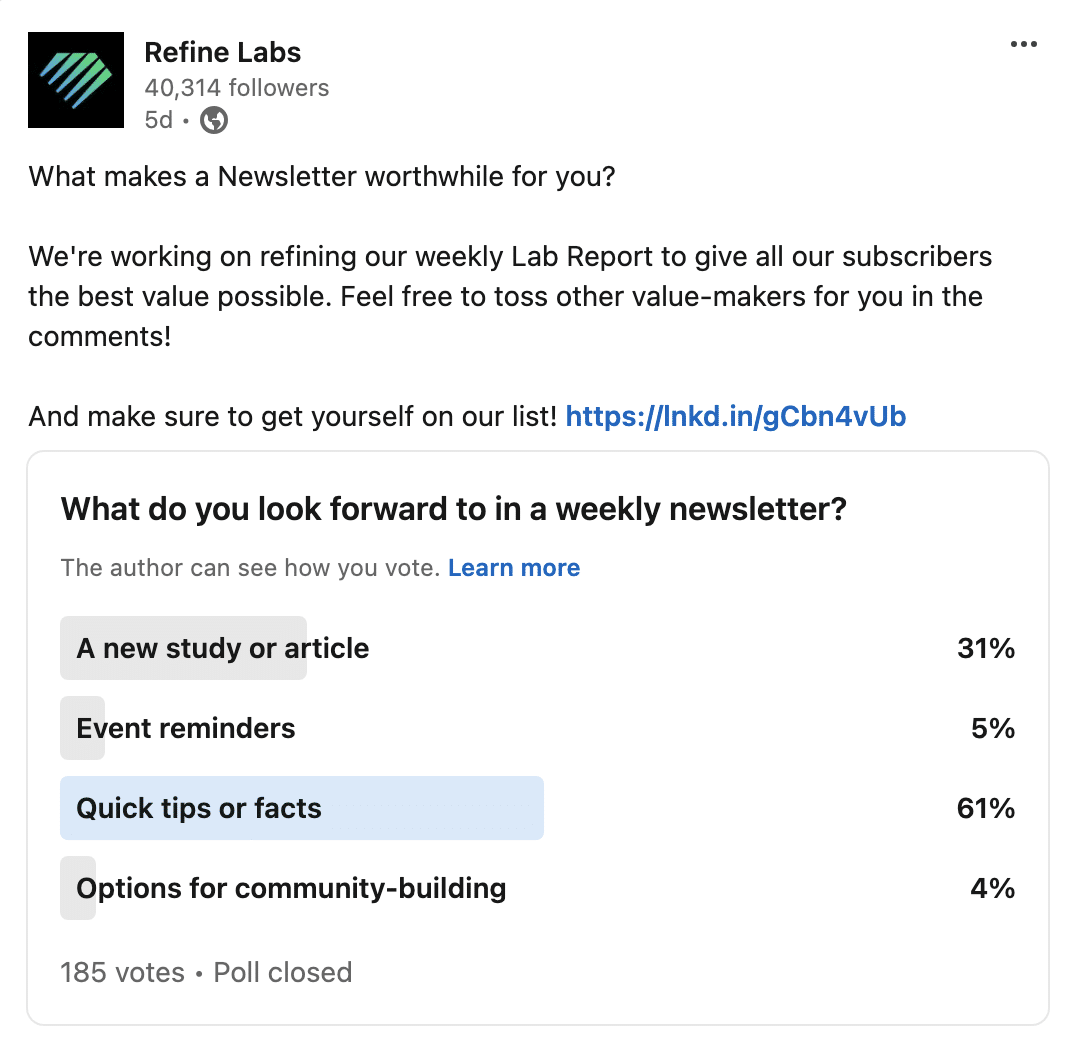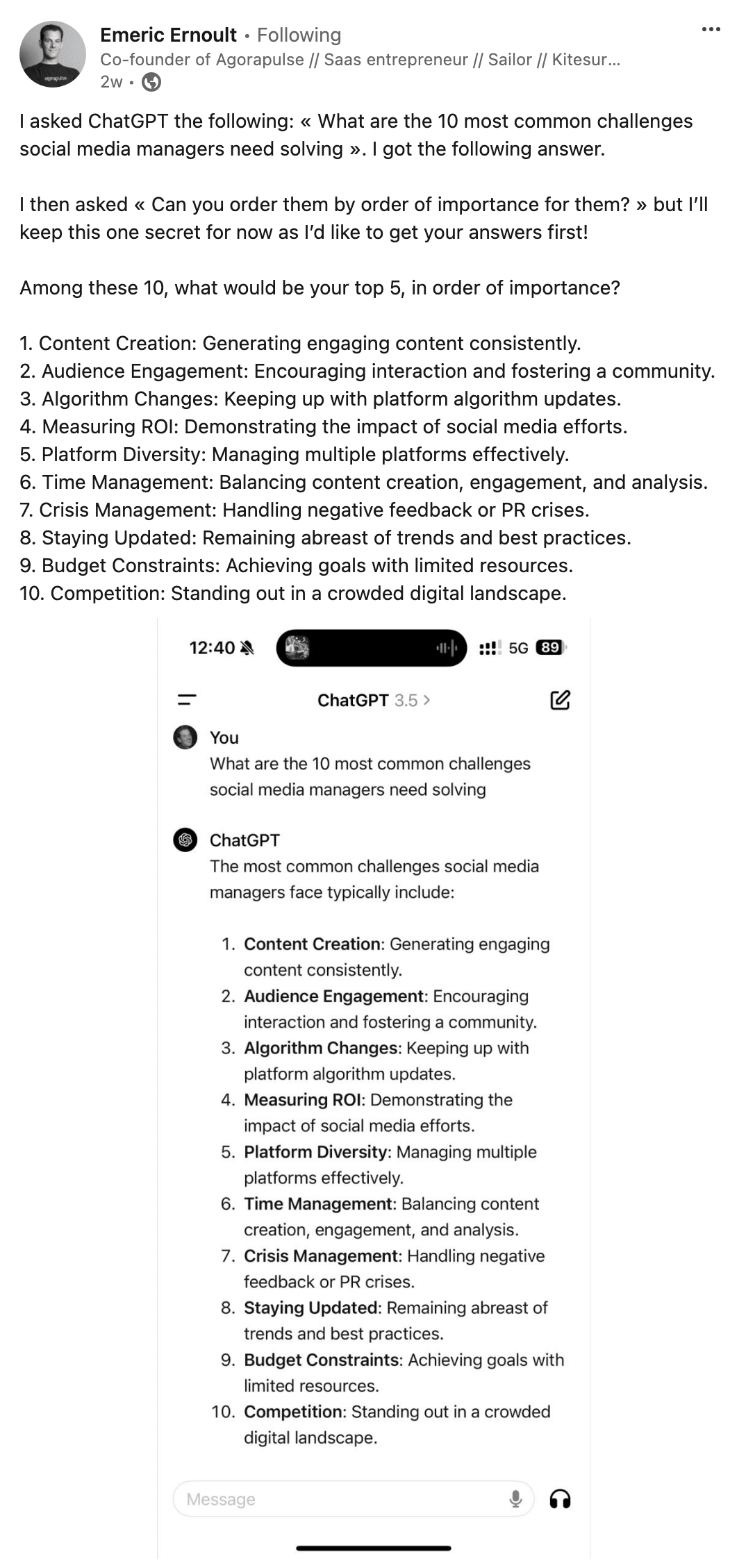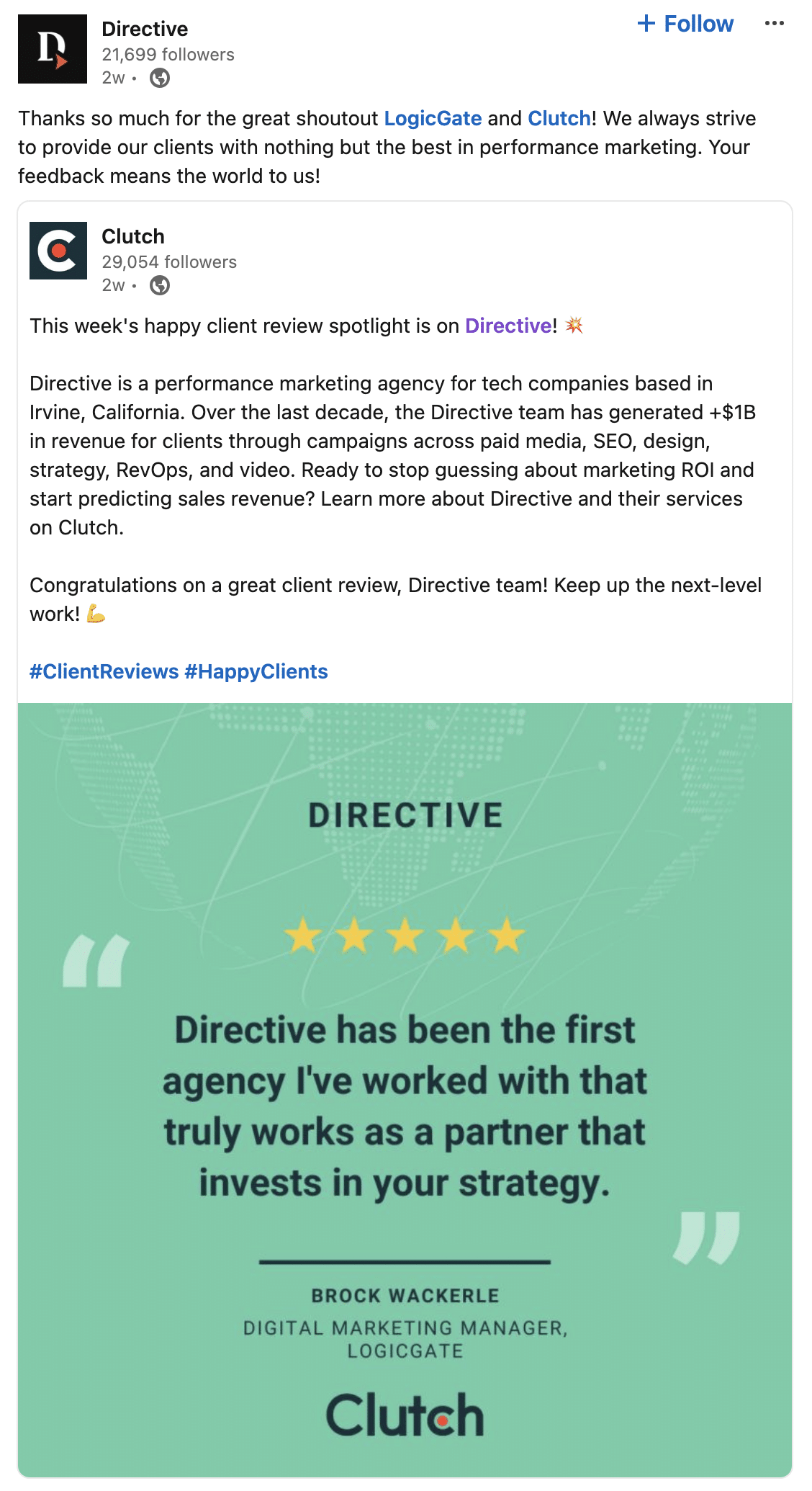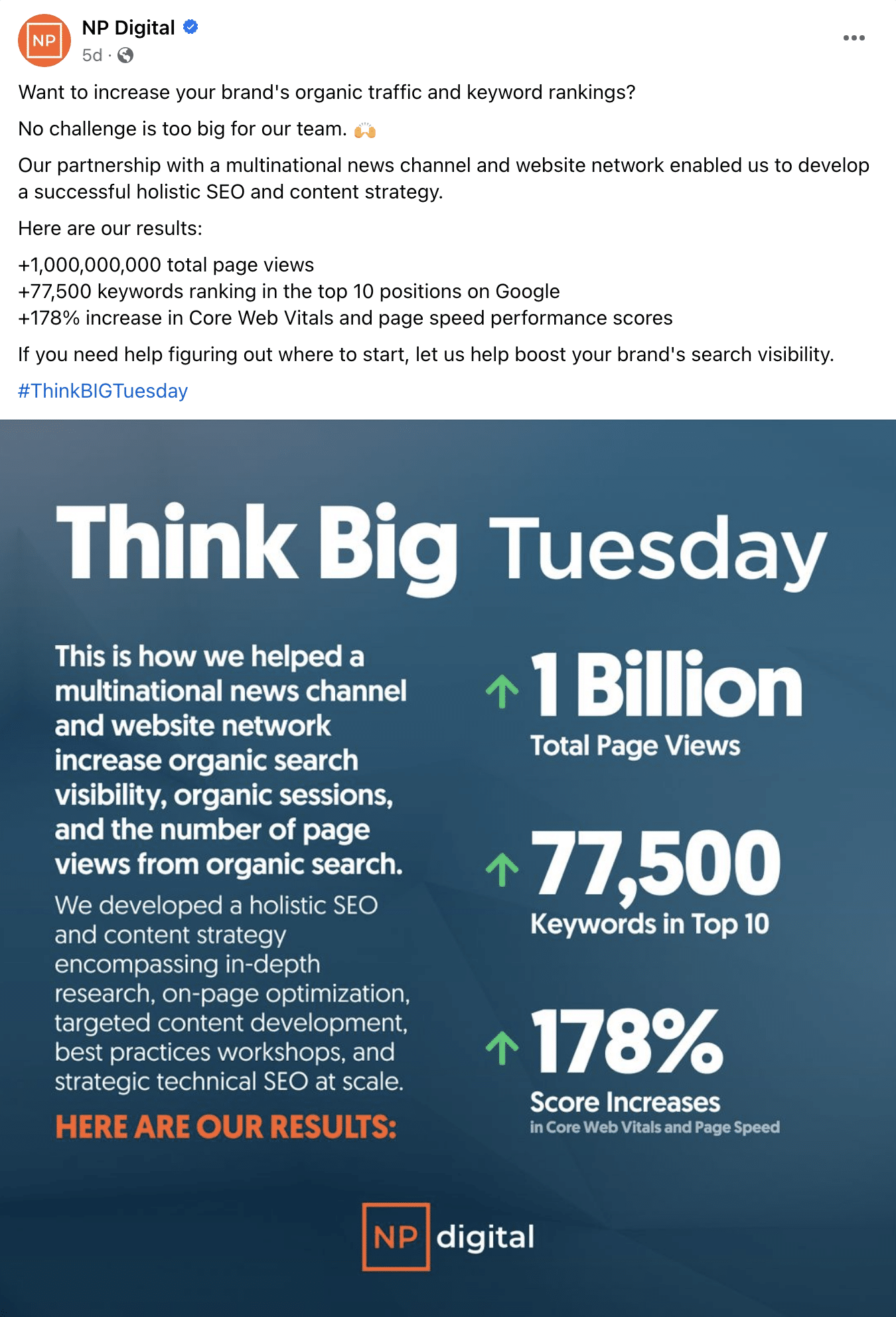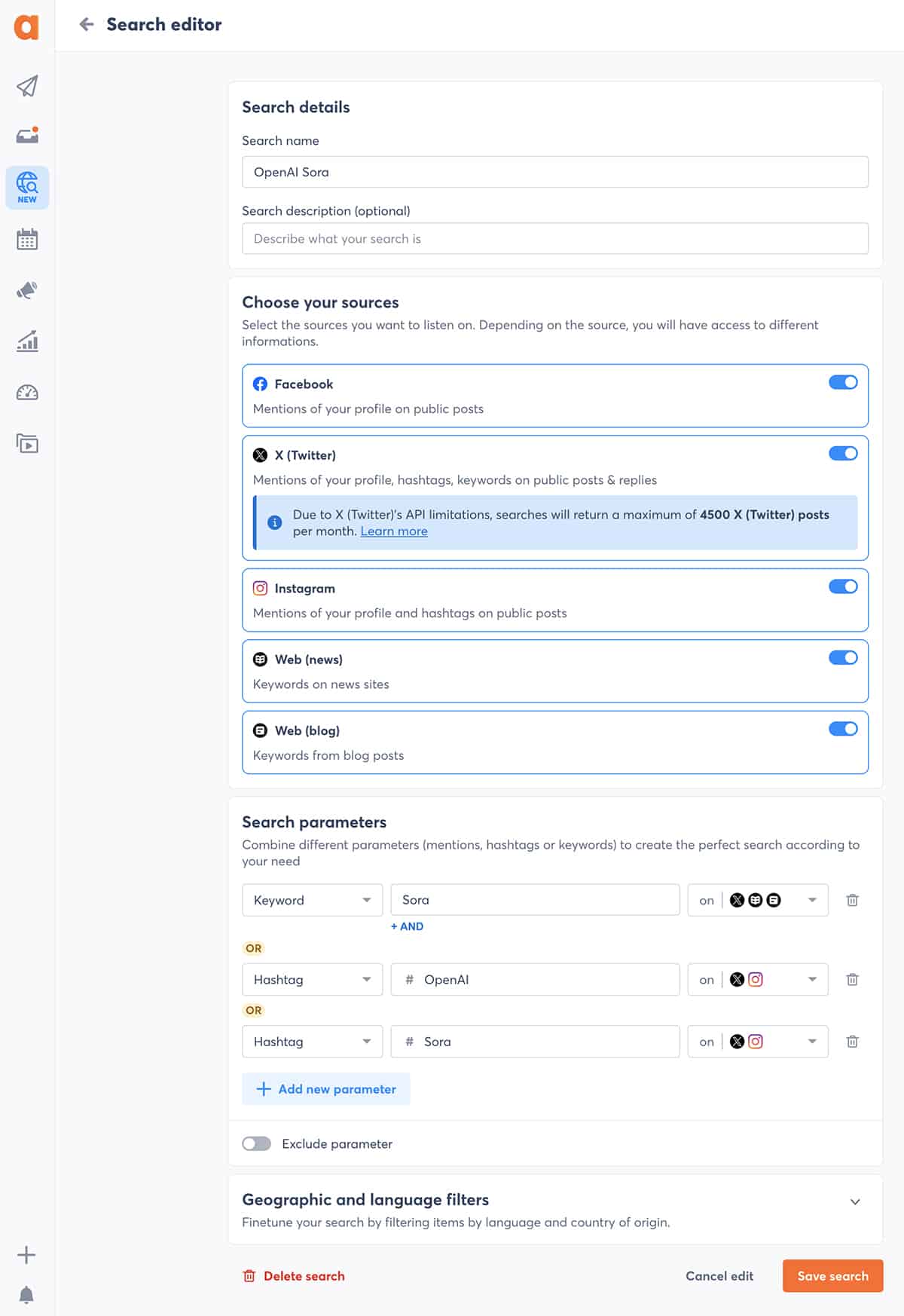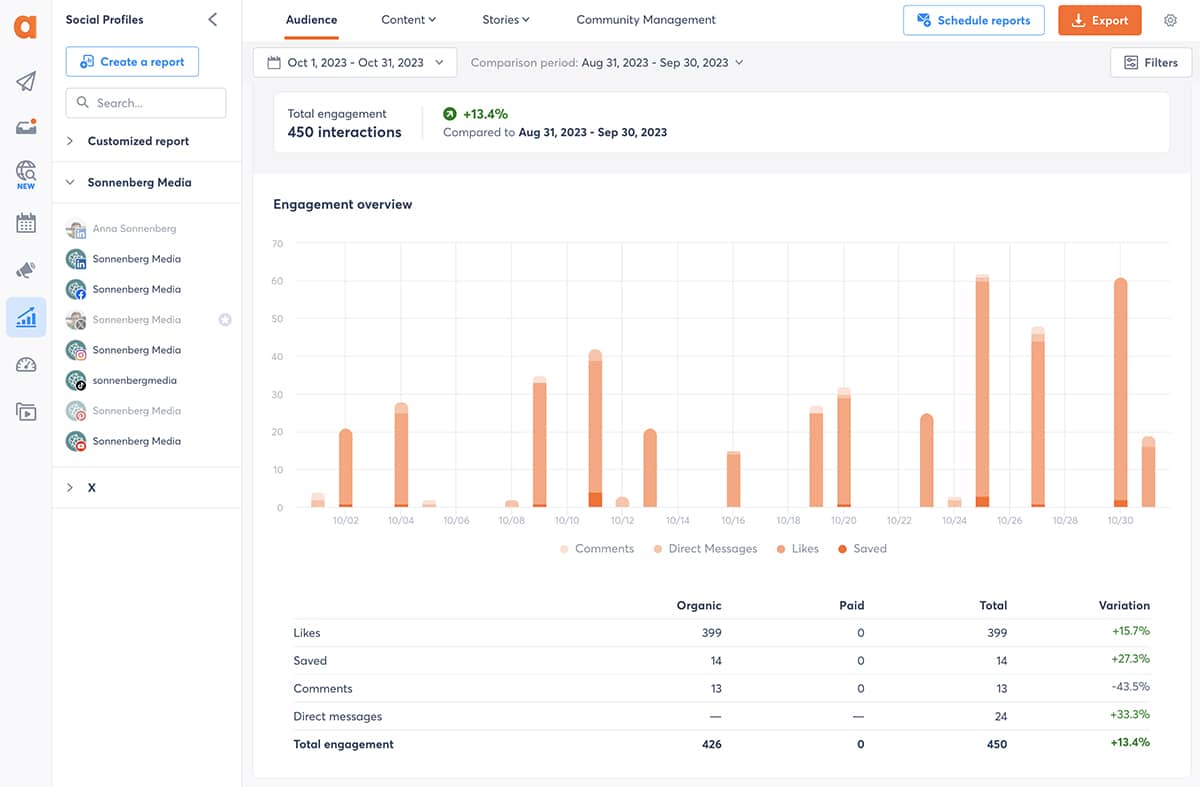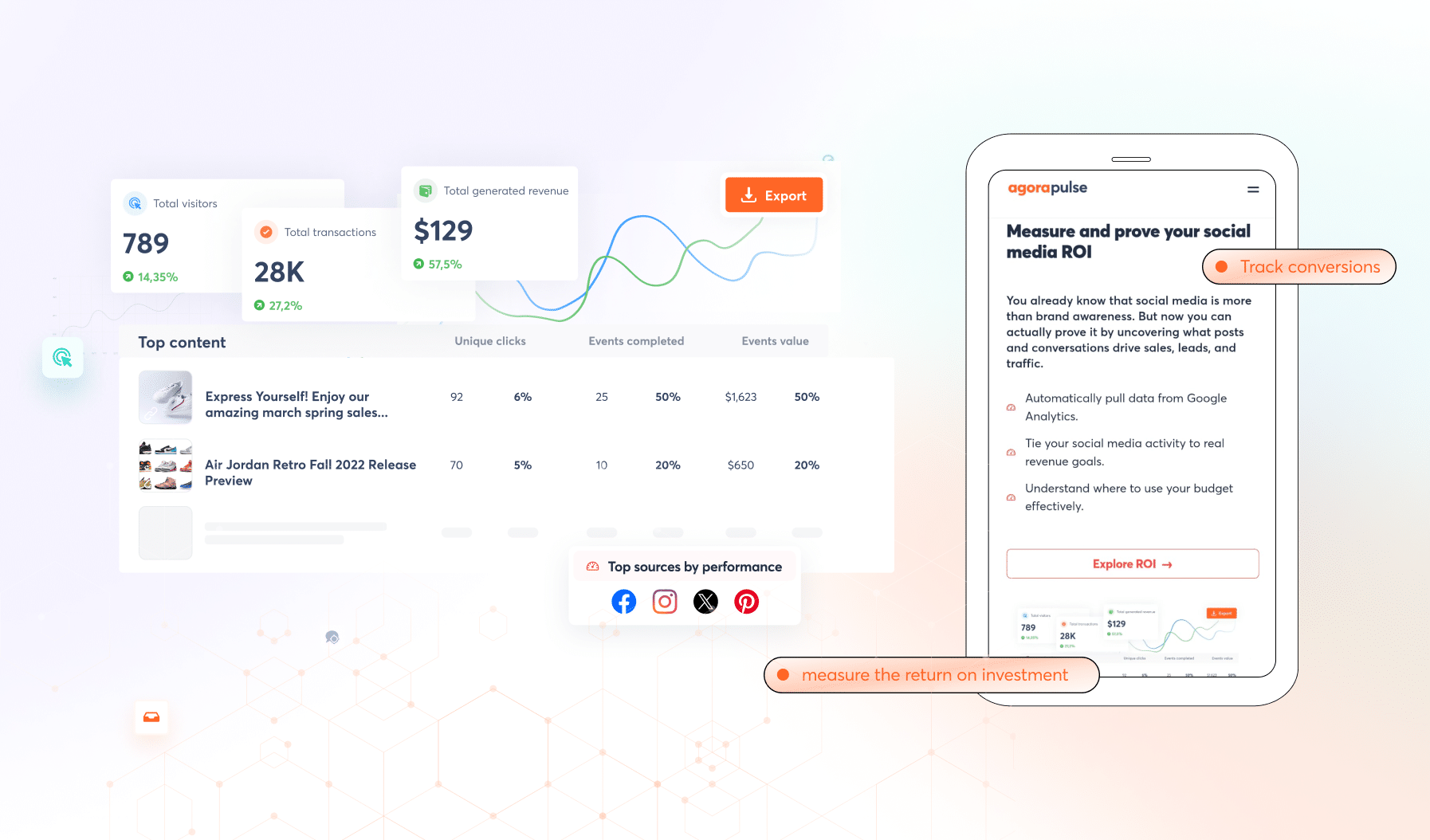Social selling can be incredibly effective for generating leads and driving sales in both B2B and B2C spaces. One reason it works so well: Instead of using traditional sales tactics, it focuses on relationship building.
What kind of results does it really drive? Experienced social sellers are 51% more likely to reach quota, according to LinkedIn. And 78% of social sellers outperform colleagues who don’t use social media in their sales workflows.
To help your team leverage this approach, we’ll do a deep dive into how to start with social selling, what challenges to expect, and how Agorapulse can support your workflows and measure the business impact of your social efforts. You can always sign up right now for a free trial of Agorapulse and get selling and measuring.
What Is Social Selling?
Social selling is the process of using social media networks to create meaningful connections with your target audience, nurture potential leads, and guide prospects through the customer journey. This sales strategy focuses on authentic engagement rather than direct sales.
Notice the definition of social selling doesn’t include:
- Making cold calls
- Purchasing lists
- Spamming prospects
Instead, social selling is all about building relationships and pipeline—so your team can hit quota.
Elements of social selling
To succeed with this strategy, you need a few essential elements. Before you begin, get clear on the following.
Value proposition
What makes your brand, product, or service unique? How does it differ from the competition?
You need to pinpoint how your product or service can help customers solve genuine problems. You also need to know how to position your brand against the competition in an accurate yet compelling way.
Buyer persona
Who is your ideal audience, exactly? You need to know your target customer’s pain points, challenges, and goals.
It’s also helpful to define your buyer persona(s) by:
- Demographics: personal attributes like location, age, and job title
- Firmographics: Business attributes like industry, company size, and organizational structure
- Technographics: Preferred technology and software
Customer journey
How do customers go from hearing about your company for the first time to making their first purchase? Map out the complete customer journey, including common marketing and sales touchpoints.
Using this data, you can identify where your social selling efforts would offer the most value. Then you’ll know where to focus and how to fine-tune your messaging.
Benefits of social selling
Is it really worth the effort and resources to invest in social selling? In many cases, the answer is a resounding yes. Here’s how your team can benefit from this approach:
- Drive better results: Nearly 90% of sellers report that social selling has a positive impact on the business, according to HubSpot. And nearly 60% report generating more sales via social media year over year.
- Build trust: A measly 3% of consumers trust salespeople, according to a HubSpot report. Social selling bypasses traditional tactics like cold calling and list buying instead focusing on trust and relationships.
- Get ahead of the competition: There’s a good chance your competitors are already testing social selling tactics. By taking a proactive approach, you can create a playbook and use this tactic to your advantage.
What’s the Difference Between Social Selling and Ecommerce?
Both social selling and ecommerce involve sales. But they take completely different approaches to selling.
Leads vs. conversions
A typical social selling strategy focuses on lead generation. Social sellers aim to attract interest, provide value, and build trust when interacting with potential customers.
In contrast, ecommerce tends to focus more on sales conversions. Ecommerce retailers aim to get their target audience to browse and buy, often offering discounts or other incentives.
Relationships vs. transactions
Sure, the end goal of social selling is acquiring a customer or marking a deal closed/won. But the process is all about cultivating relationships and sparking conversations.
For ecommerce sellers, the opposite is true. Ecommerce prioritizes encouraging transactions and generating sales with each customer touchpoint.
Long-term vs. short-term
Social selling is hardly a quick process that results in instant sales. Instead, it’s a long-term play that enables businesses to improve visibility, boost credibility, and drive more revenue over months or years.
Ecommerce sellers can certainly attract loyal customers and enjoy long-term success. But a typical ecommerce strategy is more about creating a steady flow of quick wins, making it a stronger short-term bet.
What Are the Challenges of Social Selling?
As you develop your social selling strategy, avoid these common issues:
Creating overly promotional content
Whether you’re publishing social media posts or leaving thoughtful comments, social selling should never be 100% about you or your business. Instead of simply promoting an offer, reframe your content to provide value.
Skipping steps in the customer journey
When you identify a prospect, you may feel compelled to book a demo or set up a call right away. Rather than rushing prospects to the decision stage, nurture leads and build trust during the consideration stage.
Investing in the wrong channels
Many B2B companies focus their social selling efforts on LinkedIn, but this social media platform isn’t the right choice for everyone. For B2C businesses, platforms like Facebook, Instagram, and X/Twitter tend to work better.
Neglecting to track results
If you don’t monitor your social media metrics, you’ll never know what’s working (or what isn’t). Use analytics tools to track reach, engagement, and conversions so you know where to direct your efforts.
How Do I Start Social Selling?
Let’s walk through the basics of social selling, starting with best practices and top tools.
1. Identify the right social networks
Before you invest resources into social selling, decide where to focus your efforts. The easy answer is that B2B businesses should prioritize LinkedIn, while B2C companies should focus elsewhere.
But when you want to maximize return on investment (ROI) from social selling, it’s a good idea to dive deeper. Here are a few ways to research this decision:
- Identify the channels that already generate the most activity for your business or agency. Which ones drive the most engagement or brand mentions? Which ones bring in the most revenue?
- Find the channels that fit your audience’s demographics or firmographics. For U.S.-based businesses, the Pew Research Center’s social media fact sheet is a great place to start.
- Do a little competitive research. Where do other brands in your space spend the most time and effort on social media? These channels may be worthwhile for your brand, too.
2. Create a trustworthy profile
Once you’ve decided on social networks, take some time to optimize your profile. Make it easy for potential customers to:
- Trust you: Fill out your business or personal profile completely, with a profile photo, cover image, and about section. The latter is a great place to repurpose your value proposition.
- Learn about you: If prospects are hearing about your business for the first time, they may want to research independently. Include helpful, non-salesy links to guide them in the right direction.
- Contact you: When prospects have questions, give them a low-friction way to connect with your team. DMs, emails, and contact forms are all fair game.
Not sure if your profile is fully optimized? LinkedIn has a helpful tool to check your status. The platform’s Social Selling Index (SSI) show how your personal profile rates in four different areas.
If your SSI is on the low side for your industry or your network, focus on the areas that need work. For example, put time into establishing your brand and building professional relationships.
3. Choose the right social selling tools
All you technically need for social selling is a social media profile. But by adding the right tools to your workflow, you can save tons of time and find potential customers much more efficiently.
Agorapulse
Whether you plan to prioritize LinkedIn, Facebook, Instagram, or X, Agorapulse can help you:
- Create, optimize, and schedule content to go live at the best time for your target audience
- Manage comments and messages so you never miss an opportunity to connect with prospects
- Set up social listening searches so you can tune into conversations with potential prospects
LinkedIn Sales Navigator
If you plan to use LinkedIn for social selling, you can simplify your prospecting workflow with Sales Navigator. With this tool, you can:
- Search for companies and individuals based on demographics, firmographics, and social activity
- Map out your professional network and make strategic connections at key companies
- Get automated alerts when prospects post content or when company headcount changes
4. Connect with potential customers
Strategically expanding your network is a key part of social selling. But requesting a connection or following a prospect is only the first step.
When you connect with new prospects, send a LinkedIn introduction message. Don’t make it completely about you or your business. Instead, engage new connections by asking an open-ended question or highlighting something you like about their profile or a recent post.
When prospects proactively connect with you, start a conversation. Keep your first message short and sweet.
For example, expert social seller Samantha McKenna suggests simply thanking prospects for connecting. Then allow them to guide the conversation.
5. Find and join relevant conversations
As helpful as private messages can be for relationship building, public forums can be just as effective for social selling. In fact, one of the best ways to build a rapport with potential customers is engaging with their posts.
Here, Urban Decay comments on beauty influencer Tia Shea’s Instagram Reel. By leaving a public comment, the makeup brand achieves two goals: interacting with the influencer and building awareness with her followers.
Below, H-E-B replies to a customer post, sparking a more in-depth conversation. The grocery retailer takes the opportunity to learn about the customer’s preferred products and reinforce her loyalty.
Here, Todoist takes the opportunity to respond to an X post mentioning tech influencer Marques Brownlee’s favorite productivity apps. The comment mentions a promo code as an incentive to consider a purchase.
6. Get to know your audience
Social selling is all about making genuine connections with your audience. But how well do you really know their biggest challenges and goals? Ask questions or host informal polls.
Here, Refine Labs uses LinkedIn’s poll feature to learn what subscribers want to see in a weekly newsletter. The B2B demand generation agency also uses the opportunity to encourage new signups.
Below, Agorapulse co-founder Emeric Ernoult polls social media managers about their biggest challenges. This post is helpful for both getting to know customers and doing market research.
7. Show social proof
When you share social proof, you give prospects reasons to trust you and your business. Social proof can come in many different formats, including testimonials, case studies, and press mentions.
Here, Directive shares a post by Clutch, a professional services review site. The post features a testimonial from one of Directive’s customers, which allows prospects to see what they can expect when working with the performance marketing agency.
Below, NP Digital shares a case study featuring a customer account. The post highlights the agency’s achievements, making it easy for potential customers to assess the results.
How to Do Social Selling With Agorapulse
Looking for the right social media management solution for your organization? Use Agorapulse to manage your social workflows.
Publish content consistently
Whether you’re sharing social proof or asking compelling questions, make a point of consistently publishing content to your business pages or your personal account. By posting social media content regularly, you can build trust with your target audience and generate ongoing engagement.
There’s no need to waste time toggling between social platforms or browser tabs.
With Agorapulse, you can create social media content calendars and schedule posts for all your accounts in one place. You can even repurpose posts between social profiles without having to build each one from scratch.
Managing social media with a team? When you schedule content with Agorapulse, you can assign social posts to other team members for approval. This way, you can ensure the right people sign off before posts go live.
Respond to engagement efficiently
When potential customers comment on your social posts or send private messages to your business pages, don’t leave them hanging. Take the opportunity to deepen the connection and establish a relationship.
Using Agorapulse’s social inbox, you can manage comments and messages for all your business accounts in one place. You can also assign inbox items to specific team members (e.g., salespeople) for follow-up.
Practice social listening
Want to tune in to conversations about your brand? You don’t have to rely on in-app notifications from LinkedIn, X, or other social platforms. Instead, use a dedicated social media listening tool.
Agorapulse automatically notifies you about brand mentions. But you can also set up custom social listening searches to ensure you never miss an untagged mention or a brand-adjacent conversation.
With Agorapulse’s social listening feature, you can set up custom searches for brand names, keywords, or hashtags. By enabling searches across Facebook, Instagram, X, and the web, you can find tons of conversations to join.
Leverage employee advocacy
Your business pages don’t have to do all the heavy lifting. Instead, encourage employees to get involved in social selling and put a personal spin on your company’s messaging.
With Agorapulse’s employee advocacy tool, you can take a strategic approach.
Create employee advocacy campaigns for the content you want employees to share. Provide talking points or suggest messaging. Then, let them craft social posts that are likely to resonate with their followers.
Monitor and analyze results regularly
There’s no need to spend time on tactics that aren’t producing results. Instead, monitor the results of your employee advocacy campaigns, social media content, and community management.
Agorapulse automatically pulls in analytics for all connected accounts so you can create social media reports in seconds. At a glance, you can gauge engagement and brand mentions, including how your current results compare to the prior period.
Agorapulse also highlights top content published to your social profiles. Using this data, you can refine your social content strategy and publish posts that are more likely to build trust and drive engagement.
Attribute conversions accurately
It’s true that social selling isn’t designed to drive immediate conversions. But when your social content does lead customers to convert, you’ll want to know what prompted them to take that last step.
Using Agorapulse, you can track conversions and measure the return on investment (ROI) from your social media efforts. Just add campaign tracking to any links you share in posts, comments, and DMs.
Then, check your social media ROI dashboard to identify what’s generating results. Agorapulse attributes conversions based on social profiles, channels, campaigns, content type, and even individual posts.
Start Social Selling With Agorapulse
Curious how Agorapulse can help your team improve their approach to social selling? Sign up for a free trial and start creating content, managing social engagement, and measuring ROI today.



